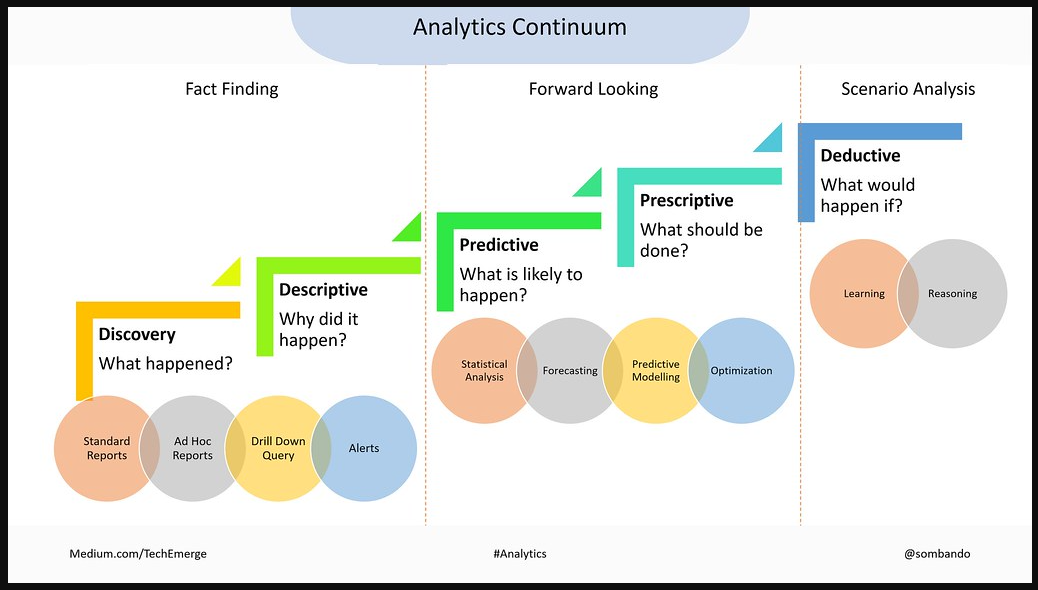
Analytics is an essential tool for businesses to gain insights into their operations and drive growth. There are three main types of analytics: descriptive, predictive, and prescriptive. In this article, we'll explore the role of each of these types of analytics in business.
Descriptive Analytics
Descriptive analytics involves the use of historical data to understand what happened in the past. This type of analysis is used to identify trends and patterns in data, and to gain insights into how a business is performing. Some of the key features of descriptive analytics include:
- Historical Data
Descriptive analytics is based on historical data. This data can come from a variety of sources, including sales data, customer data, and operational data.
- Visualization
Descriptive analytics often involves the use of visualization tools to help identify patterns in data. This can include charts, graphs, and other visual representations of data.
- Key Performance Indicators (KPIs)
Descriptive analytics is often used to track key performance indicators (KPIs) that are important to a business. This can include metrics such as sales growth, customer retention, and operational efficiency.
Predictive Analytics
Predictive analytics involves the use of statistical models and machine learning algorithms to make predictions about future events. This type of analysis is used to identify trends and patterns in data, and to forecast what is likely to happen in the future. Some of the key features of predictive analytics include:
- Statistical Models
Predictive analytics involves the use of statistical models to analyze data and make predictions. These models can be complex and may involve machine learning algorithms.
- Data Mining
Predictive analytics often involves data mining, which is the process of extracting patterns and trends from large data sets. This can involve the use of machine learning algorithms to identify patterns that are difficult to detect using traditional statistical methods.
- Forecasting
Predictive analytics is used to forecast what is likely to happen in the future. This can include forecasting sales growth, customer retention, and other key metrics.
Prescriptive Analytics
Prescriptive analytics involves the use of mathematical models and optimization algorithms to make recommendations about what actions a business should take. This type of analysis is used to identify the best course of action to achieve a specific goal. Some of the key features of prescriptive analytics include:
- Mathematical Models
Prescriptive analytics involves the use of mathematical models to analyze data and make recommendations. These models can be complex and may involve optimization algorithms.
- Optimization
Prescriptive analytics is used to optimize business processes to achieve a specific goal. This can include optimizing production processes, supply chain operations, and other key business processes.
- Decision Making
Prescriptive analytics is used to inform decision making by providing recommendations about the best course of action to achieve a specific goal.
The Importance of Analytics in Business
Analytics is becoming increasingly important for businesses to remain competitive. By using analytics to gain insights into their operations, businesses can make informed decisions that drive growth and innovation. Some of the key benefits of analytics in business include:
- Improved Decision Making
Analytics enables businesses to make more informed decisions based on data and insights, rather than relying on intuition or guesswork.
- Increased Efficiency
Analytics can help businesses identify inefficiencies in their operations and take action to address them. This can lead to increased efficiency and cost savings.
- Enhanced Customer Experience
Analytics can help businesses better understand their customers and their needs, enabling them to deliver a better customer experience. This can lead to increased customer loyalty and retention.
- Improved Innovation
Analytics can help businesses identify new opportunities for innovation and growth. By analyzing data and uncovering insights, businesses can develop new products and services that better meet the needs of their customers.
Conclusion
Descriptive, predictive, and prescriptive analytics are all important tools for businesses to gain insights into their operations and drive growth. By using analytics to inform decision making, businesses can make informed decisions that drive innovation and competitive advantage.